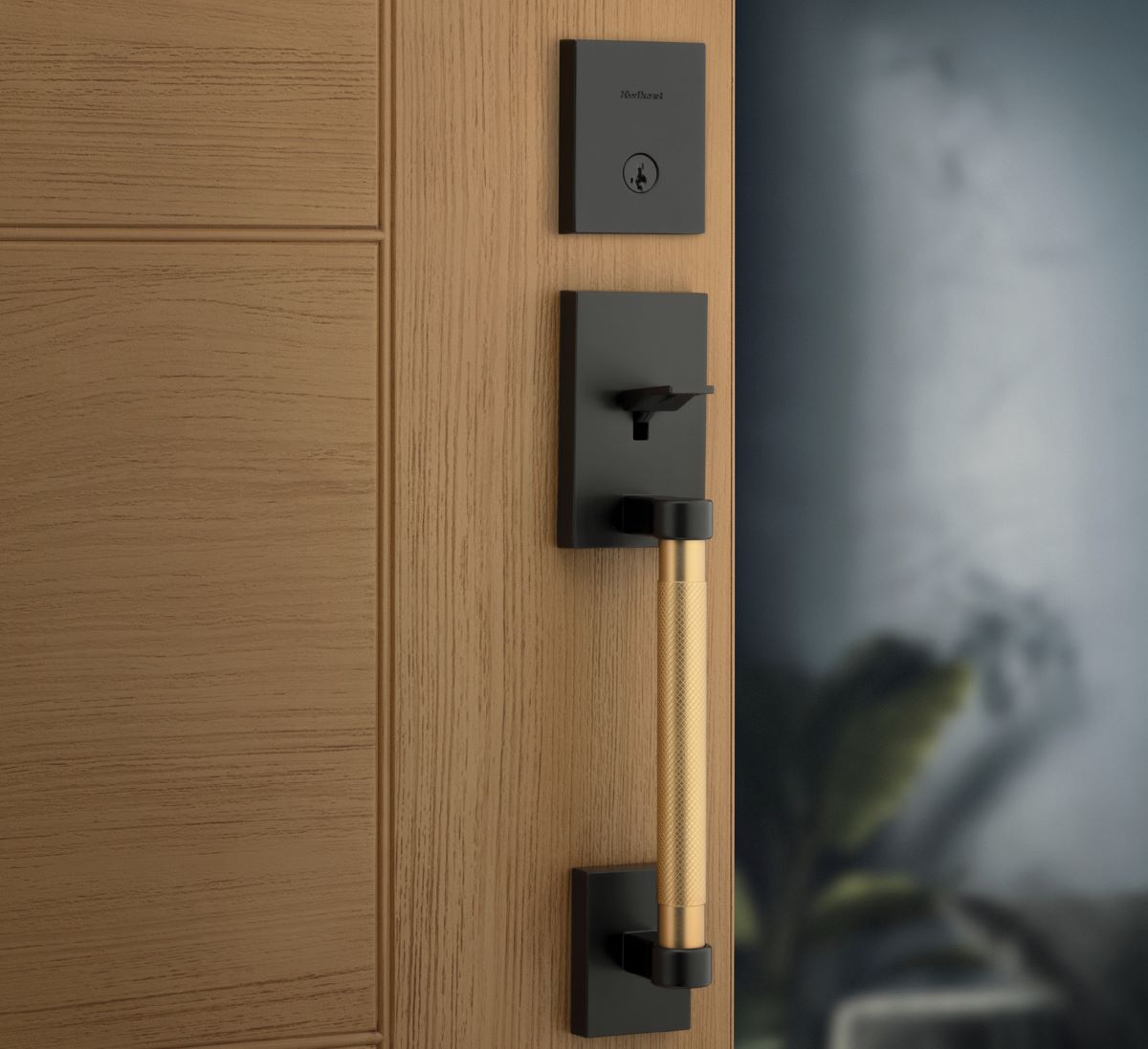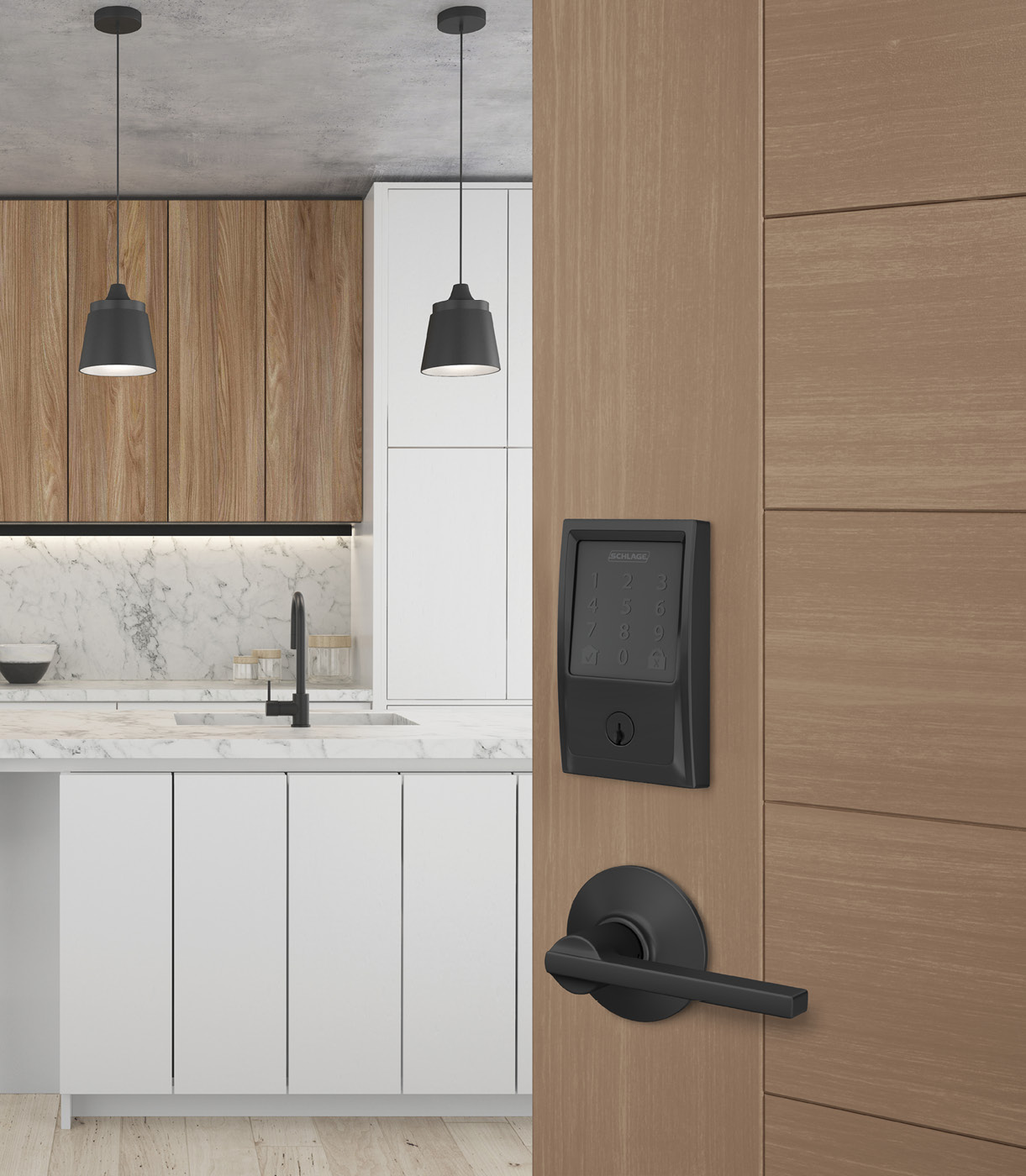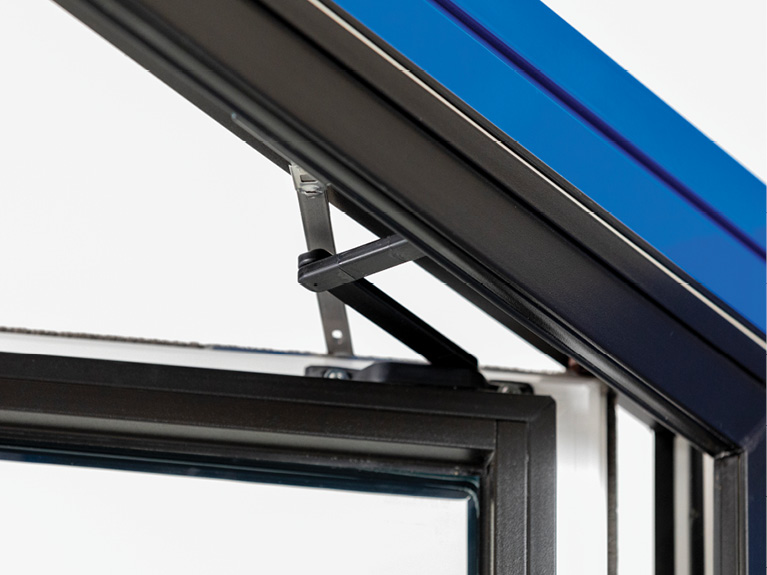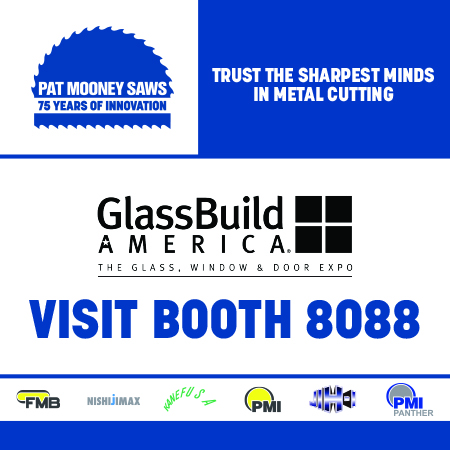Technology and Trends Shaping Today’s Hardware
Hardware suppliers discuss trends, challenges and opportunities in the market

Above: The newer style of the Kwikset Prava handleset in matte black and satin brass features a knurled texture and mixed metal finish. It’s also available in satin nickel.
Black colors, mixed metals, automation and concealed hardware are among the trends affecting today’s hardware design. “The push for innovation in window and door hardware is being driven by the need for products that enhance convenience, safety and affordability,” says Michelle Nissen, vice president of product management and engineering, Quanex (AmesburyTruth).
And while keeping pace with what consumers want, hardware manufacturers are also navigating economic uncertainty and labor challenges alongside the rest of the supply chain. “We lost a whole generation of people in 2008, not only in the trades and with not having enough people to build houses, but you also lost the people that were gaining that knowledge about products and project management,” says Larry Whitt, business development manager, Jeske Hardware.
Design appeal
“Consumers are seeking sleek, minimalist window and door hardware that seamlessly blends into its surroundings while coordinating with other home fixtures. While satin brass and brushed nickel remain popular choices, matte black is rapidly gaining traction for its sophisticated, modern appeal,” says Nissen.
Dan Gray, director of sales, North America, Roto Frank of America, agrees. “Black is huge,” he says. “Everybody’s looking for black hardware to go with their black windows.” White remains the dominant color, but some of Gray’s customers report that black represents 20% to 30% of their color mix.
“Black has just grown exponentially in residential and commercial, though commercial was a couple years behind residential,” says Whitt. “Now, you’re really seeing black as a strong number two finish in the commercial world behind the dull chrome stainless steel finishes and satin brass.”
Whitt also says KwikSet’s antimicrobial finish is big in residential and is expanding into commercial. He attributes some of that growth to the COVID-19 pandemic, as well as the growth of products that accommodate hands-free operation, especially in commercial spaces.
Beth Basch, director of marketing, Jeske Hardware, sees mixed metals gaining traction, too, such as pairing black and brass or black and nickel. “There’s more interest than just a solid color,” she says. “People are more willing to mix it up.”
A mix remains between bolder hardware styles, especially prevalent on wood windows and doors, and concealed, minimalistic hardware, which Gray sees as more prevalent on PVC products. “There’s more of an interest in having less hardware, trying to increase the sight lines with thinner profiles,” he says. “Manufacturers want to see less and less hardware.”
Performance
Aesthetics may be what people first look at when selecting hardware, but performance must be right up there alongside beauty. Gray says customers are trying to keep pace with Energy Star requirements and other performance criteria. “Part of the trick there is maintaining a very manageable operating force and still having the level of performance,” Gray explains.
Safety considerations also abound. Window opening control devices, or WOCDs, remain prominent. Gray speaks to a shift in codes in Canada, starting in British Columbia, where the code language requires a WOCD, which has never been required by code before. Gray notes this is a big business opportunity that will affect single-family, mixed-use and commercial buildings.
Gray says hardware can’t be certified to Americans with Disabilities Act compliance; rather, it’s the finished window or door system that is certified. Therefore, the manufacturer must consider operating force, which is where hardware comes in. “We take our entire hardware system, work with a fabricator with their profile and optimize the hardware to create the lowest operational force for them,” Gray explains.

Above: The matte black Century Encode is Schlage’s most popular electronic lock, and the Latitude lever in matte black is popular as well.
Technology

Technology makes new gains in the window and door world every day. From automating the opening and closing of windows and doors to smart glass, no element of a unit is off-limits.
The AmesburyTruth product team at Quanex is introducing a solution that connects electricity to glass in operating units. “This breakthrough enables smart glass technologies, such as switchable privacy glass, electrochromic tinting, solar energy harvesting and motorized blinds between the glass—expanding beyond traditional fixed or stationary window applications,” says Nissen.
Roto, meanwhile, is partnered with AutoSlide, which is an electronic device that can mount above a sliding or hinge patio door and allows the user to open and close the door on demand via an app or keypad.
Finding the right market for automated solutions can present challenges, though. “Our market is almost 100% the original equipment manufacturer and we’re finding many don’t want to deal with electronics from an installation and after-market perspective,” says Gray. “They know how to service their windows and doors from an operational and functional perspective, but servicing something with electronics puts them into a whole other category.”
Technology continues to work to integrate with the Matter protocol, an open-source smart home standard that allows devices from different manufacturers to communicate with each other. “You’re starting to see everything shift toward working through the Matter protocol so that you can choose your hardware,” says Whitt.
One such Matter-enabled device is Schlage’s recently introduced Sense Pro. It doesn’t have a key; rather, it’s electronic and uses an app on a smartphone or smart watch.
It will sense when the user is approaching the door and automatically unlock the door. Because it uses the Matter protocol, explains Whitt, it will connect through any smart home app the user wants to use. Ultimately, Matter will allow a homeowner to control any smart home device—from doors to appliances to lighting and more—through a single app of their choosing.
Market demands
Housing affordability remains a top priority for the National Association of Home Builders. As the market continues to grapple with affordability concerns, manufacturers and suppliers are taking note. “With the growing challenge of affordable housing, the industry is under pressure to deliver cost-effective solutions. We are actively collaborating with our engineering team to develop innovations that meet these demands, ensuring high-performance products remain accessible to a broader market,” says Nissen.
Labor shortages and succession planning also factor in business decisions. “Roto, as well as many other companies in this industry, are faced with a substantial succession plan in their personnel going forward,” says Roto’s Gray. “It’s going to be fascinating to see what happens. I think this is one reason why I believe the GlassBuild America show floor today is more than 50% dedicated to manufacturing equipment, because the fabricators are spending money on automation because they have labor concerns. They know in three to five years they’re going to have succession to deal with. I think they’re making investments now, so they’ll be prepared to have a reduced workforce that is knowledgeable going forward.”
Jeske’s Whitt agrees labor is a top concern. “You're starting to see a lot of the experienced hardware people retiring. One of our biggest areas of growth is training our project managers to help our customers. It’s not always about price. Sometimes, it’s about who can help get the job done and make it work.”
Jeske uses technology to automate as many processes as possible, explains Whitt. This enables the company to store information in one place, thereby increasing efficiency and accuracy.
“Instead of having 10 highly skilled people on staff, we can have two or three and they can help others,” he says. “The biggest way you learn is through mistakes, so you need to have a good process to take care of issue and problems as quickly as possible.”
Jeske’s Basch also notes the company compiled training materials to start people at the basics, no matter what department they come into. “It’s hard to find anyone with knowledge of hardware, so we have to create our own,” says Whitt. “If we can find those employees that can learn, you start out with the basics—metals, finishes, types of products, functions—and build from there. Then they learn through experience.”
Nissen sums the hardware market up neatly: “The window and door hardware market is entering an exciting phase of growth and innovation, driven by strong customer partnerships and evolving industry needs. Smart technology is gaining momentum, but the real challenge lies in developing affordable solutions that are accessible to a broader market, not just high-end buyers. Additionally, with the ongoing affordable housing shortage, our customers are seeking collaborative partners to help identify opportunities and deliver cost-effective, high-performance solutions that bridge the gap.”




